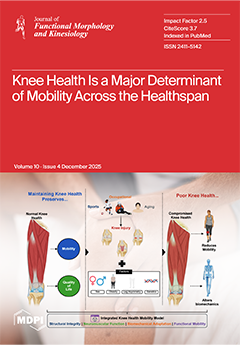Objectives: To characterise multidomain physiological responses to a maximal cycling effort and identify consistent physiological responder profiles. A secondary objective was to compare professionals and amateurs and assess the practical value of these profiles for personalised monitoring and performance management.
Methods: This observational study included 22 trained male cyclists (10 professionals, 12 competitive amateurs; age 27.6 ± 6.4 years; height 177.3 ± 5.5 cm; weight 65.5 ± 4.1 kg). Participants performed a maximal 20-min functional threshold power (FTP) test and complementary assessments (Bosco jump tests, blood pressure, heart rate, lactate, glycaemia, creatine kinase, albuminuria) across three time points (baseline, immediately post-FTP, and 24 h post-FTP). Statistical analyses included
t-tests, ANOVA, and Spearman correlations, for recovery dynamics, with significance set at
p < 0.05.
Results: Professionals exhibited significantly higher FTP (5.5 ± 0.3 vs. 4.3 ± 0.4 W/kg,
p < 0.001), greater post-exercise lactate (13.8 ± 1.6 vs. 11.2 ± 1.4 mmol/L,
p < 0.01) and higher CK 24-h responses (412 ± 86 vs. 291 ± 74 U/L,
p < 0.05). Cardiovascular and metabolic recovery slopes were faster in professionals (
p < 0.05). Despite lower baseline jump values, professionals showed reduced neuromuscular fatigue (SJ post/pre = 0.94 ± 0.04 vs. 0.88 ± 0.05,
p < 0.05). FTP correlated strongly with 5-min all-out power (
r = 0.76,
p < 0.01) and Wingate mean power (
r = 0.75,
p < 0.01). Eight responder profiles emerged across four physiological domains, with professionals predominantly showing multi-domain adaptation patterns. Although additional variables, such as elevated albuminuria and altered Elasticity Index (EI), provide insight into renal and neuromechanical stress responses, they were excluded from the final profiling due to limited practical interpretability.
Conclusions: Fatigue and recovery in prolonged cycling show substantial interindividual variability across neuromuscular, metabolic, cardiovascular, and biochemical domains. Professional cyclists display faster recovery and more frequent multidomain responder profiles. The four-variable model (FTP, lactate, CK, SJ post/pre) enables clear identification of physiological responder types and offers a practical, integrative framework for personalised monitoring and performance management.
Full article






